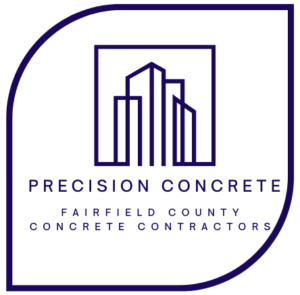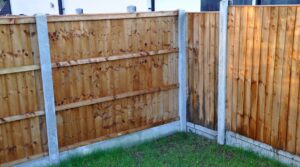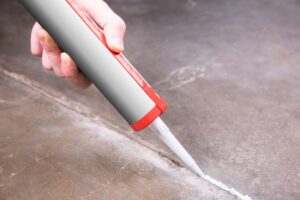Putting pavers over concrete is a popular upgrade for any outdoor space. This method, often called overlaying, allows homeowners to enhance the aesthetic appeal of their patios and walkways without removing the existing concrete. Installing pavers over a concrete patio involves a unique set of steps that differ from laying pavers on raw earth. Many individuals find this option desirable as it provides a sturdy base and reduces the complexity of complete paver installation. For those considering laying pavers over concrete, it is a path worth exploring, guiding your patio from bland to grand.
Planning is crucial when installing concrete pavers for a home renovation project because it ensures durability, functionality, and aesthetic appeal. A well-thought-out plan helps you measure the area accurately, ensuring you purchase the suitable materials and avoid costly shortages or excess. Proper planning also includes considering drainage, as pavers must be installed on a slope to prevent water pooling, which could cause damage over time.
Additionally, planning allows you to select the appropriate paver design, color, and pattern to complement your home’s overall landscape and architectural style. This ensures the finished product enhances curb appeal and property value. Preparing a clear plan of attack for your project also helps identify underground utilities and avoid damaging them during excavation. Being better prepared at the beginning will also help you better organize the project timeline, ensuring efficient work without unnecessary delays or complications and saving time and money.
Keep reading to discover the key steps and tips for ensuring a successful installation and lasting beauty for your outdoor space.
I. Understanding Pavers Over Concrete
When considering an upgrade to an outdoor space, opting for pavers over existing concrete surfaces, such as a patio, merges aesthetics with practicality. Concrete pavers are distinct units, often made to mimic the look of natural stone, which can be installed atop a concrete slab. This overlay approach appeals to homeowners for its relatively straightforward process, involving the placement of sand to even out surface irregularities, spreading adhesive to secure the pavers, and ensuring proper drainage. Such upgrades must be approached with a clear understanding of both the advantages they bring to a space and the inherent limitations they may possess. Let’s take a deeper look into what all in involved in laying pavers over a concrete foundation:
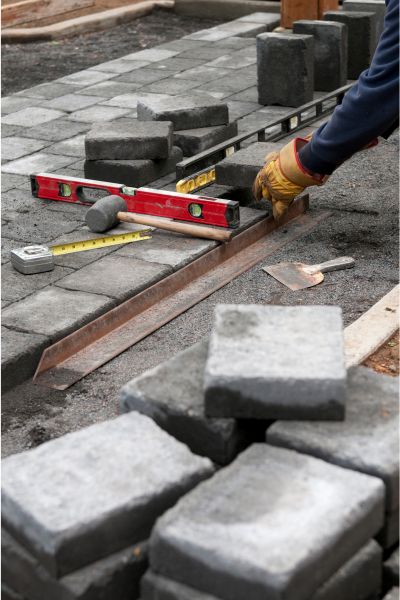
A. What Are Concrete Pavers?
Concrete pavers are precast blocks of concrete, often used to create even and attractive surfaces for concrete patios, driveways, and lawn areas. Unlike poured concrete, these pavers are individual pieces laid out to form patterns. They can be fixed in place with mortar, allowing for a more tailored and visually diverse outcome than traditional concrete slabs. Their modularity offers flexibility in design, quickly shaping outdoor living spaces while maintaining durability.
B. Benefits and Limitations of Overlay Installation
Opting to overlay brick pavers directly onto an existing concrete slab offers a swift outdoor space transformation. However, this method may present challenges, such as ensuring the underlying cement is in good condition to avoid future shifting or cracking of the pavers. Further, adding pavers on top of concrete, particularly near a retaining wall, requires careful consideration of the wall’s capacity to handle the change in surface height without compromising its stability.
II. Pre-Installation Considerations
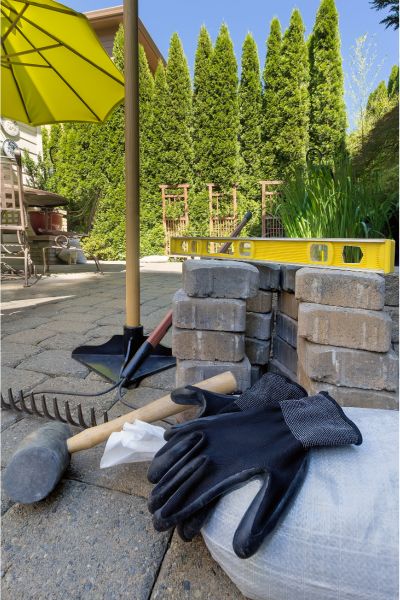
Before transforming your outdoor space by installing pavers over concrete, preparing and ensuring a strong concrete foundation is crucial. Assessing the concrete base for cracks or damage is the first step, setting the stage for a successful upgrade. Stable soil under the concrete slab supports the weight and prevents future shifting. The right tools and materials are equally vital, providing the means to cut the pavers, lay them out accurately, and establish a secure bond to the existing concrete. Equipping oneself with a clear plan and the proper tool kit will enable smooth progress as one transforms the landscape into a seamlessly tiled outdoor area.
A. Assessing Your Concrete Base
Before commencing paver installation, evaluating the existing concrete foundation is a critical first step. Check for noticeably even surfaces where water pools, as this may indicate inadequate drain systems, which can undermine the pavers over time. A thorough inspection should highlight any uneven areas or faults in the building materials, as pavers typically require a smooth surface less than one inch below the adjacent grade to ensure proper paving stability and water runoff.
B. Necessary Tools and Materials
Gathering the necessary tools and materials is as crucial to the success of your paver installation as a good design is to the overall aesthetic. For a stable sidewalk or road, you will need a screed to level the sand foundation, which is essential for the longevity of your pavers. Do not leave it to luck to have all the supplies on hand before beginning your project; a well-prepared approach ensures a smoother installation process. Be proactive and make sure everything is ready when you are!
III. Step-by-Step Pavers Installation Guide
Planning is crucial when installing concrete pavers as part of a home renovation project because it ensures the job is done efficiently, cost-effectively, and with long-lasting results. Proper planning helps determine the layout, design, and material needs, preventing costly mistakes or needing adjustments later. It also accounts for drainage, slope, and ground preparation, which is critical for avoiding water pooling and uneven surfaces that could damage the pavers over time. Starting off on the right foot is crucial to the overall success of the installation. Here is what you need to know as you follow the step-by-step process for yourself:

A. Preparing the Concrete Surface
Starting with a clean base is crucial for the longevity of any construction project, and laying pavers over concrete is no exception. After removing debris and ensuring the surface is clean, it is necessary to address any unevenness or damage. Fill significant cracks or potholes with a layer of gravel to create a level base. Use a circular saw with a masonry blade to smooth rough edges, particularly around stairs or corners. This meticulous preparation creates a stable foundation that can support the weight of the pavers and daily foot traffic, contributing to a more durable finished surface.
B. Applying Landscape Fabric
After the initial preparation of the concrete surface around the porch, the next step is the application of landscape fabric. This fabric acts as a barrier, reducing moisture build-up and weed penetration that could otherwise compromise the stability and appearance of your home improvement project. Lay the fabric evenly across the surface, cutting it to fit snugly against the perimeter, ensuring that all seams overlap to provide comprehensive coverage. Once in place, secure the fabric with a broom sweep to remove any air pockets and create a flat, tight layer upon which the sand and pavers rest.
C. Spreading the Paver Sand
Spreading the paver sand correctly is vital in establishing a robust base for the walkway. This layer helps prevent efflorescence, a common issue where salts migrate to the surface of the pavers, and protects against potential damage from moisture rising from the basement. Applying a consistent layer requires knowledge of the specific type of sand used, which should be compacted with a steel tamper to ensure a uniform and stable subsurface for the pavers.
D. Installing Edging and Pavers
After the sand bed is prepared, installing the edging is your next move. The edging acts as a curb to hold the pavers in place, preventing the spread of mud and maintaining the dreamlike appearance of your neatly arranged pavers. Choose sturdy plastic or metal edging to ensure the borders of your pavers resist movement and provide long-term stability to your project. After the edging is secured, you can begin to lay down the pavers, paying close attention to each piece’s pattern and fit.
E. Applying Polymeric Sand
Once the pavers are set, applying polymeric sand is the next critical step in the paver overlay process. It involves pouring the sand over the pavers and sweeping it into the joints with a brush. Sufficient pressure is applied with a compactor to ensure the sand is snugly packed between the pavers, which solidifies the arrangement and locks the pavers in place. If the project includes overlay concrete steps with pavers, an angle grinder may prepare the edges for a precise fit, followed by a layer of thinnest to ensure a bond that stands the test of time.
IV. Care and Maintenance of Pavers
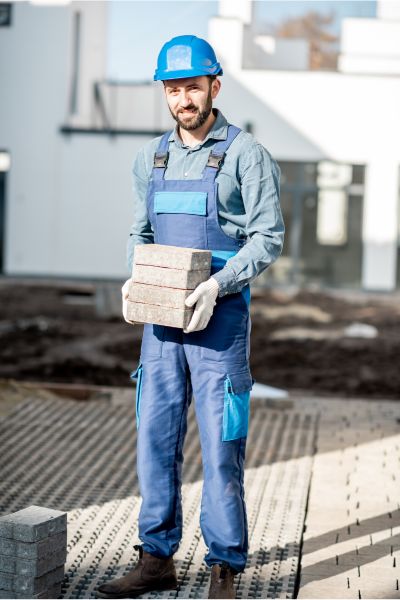
Maintaining the appearance and integrity of pavers over cement surfaces requires consistent care. Despite their reputation for durability, pavers on concrete slabs, especially those used within outdoor environments, will need regular cleaning to keep their appearance fresh and prevent weed growth. Concrete overpavers can bear the brunt of the elements; however, neglect can deteriorate their aesthetic and structural quality. Routinely inspecting pavers on top of concrete patio areas enables homeowners to head off problems before they escalate. Additionally, those with brick pavers on top of concrete will often need to examine and replenish the joint sand, ensuring the pavers remain securely in place and continue to provide a seamless surface underfoot.
A. Routine Cleaning and Preventing Weeds
Regular upkeep is integral for those who install pavers on concrete, preventing the natural elements from eroding the space’s beauty. The effort to maintain concrete over brick pavers includes removing debris and washing the surface to deter weed growth and maintain a pristine appearance. For those who have installed pavers with concrete, vigilance ensures that the space remains as inviting and functional as when first completed, keeping pavers on top of concrete looking their best.
B. Inspecting and Replenishing Joint Sand
Meticulous examination and timely replenishment of joint sand between pavers are essential to maintain stability. Periodically sweeping sand into the joints helps guard against settling, which can cause unwanted movement or sinking of the pavers. This upkeep ensures a consistently level surface and preserves the overall interlocked structure, enduring through years of outdoor exposure.
V. When to Call a Professional for Paver Installation in Fairfield County, CT
If you encounter complex issues that persist despite your best efforts or if the project scope expands beyond a simple overlay, seeking professional assistance ensures precision and prevents costly errors. Professionals bring expertise and specialized equipment to handle unexpected challenges, such as significant sub-base damage or complicated design elements.
When installing around structures that require meticulous attention, such as pool decks or landscapes with intricate patterns, an experienced installer will achieve the desired outcome with symmetry and proper alignment. Their skill in cutting and fitting pavers can add a distinguished look to the finished project, often unattainable without years of practice.
Finally, professional concrete services offer peace of mind through warranties and consistent post-installation support for those who prefer a guarantee of longevity and quality. Reaching out to experts in paver installation can protect your investment by ensuring that the pavers are laid correctly, adhere to industry standards, and have the durability to stand the test of time.
Conclusion
Properly installing pavers over concrete ensures a stable and attractive outdoor space. This process starts with assessing the existing concrete slab and carefully layering materials. Regular maintenance, such as cleaning and sand replenishment, upholds the aesthetics and structure of the paved area. For intricate or challenging projects, the expertise of a professional installer can provide precision, prevent costly mistakes, and guarantee the longevity of the pavers. Utilizing the proper techniques and considering expert help when necessary, can dramatically enhance and preserve the value and appearance of outdoor spaces.
Thoughtful planning is essential for a successful concrete paver installation in any home renovation project. It ensures accurate material estimates, proper drainage, and a design that complements your home’s aesthetics. Planning also helps avoid costly mistakes, like damaging underground utilities or miscalculating the layout, which could lead to long-term structural or water-related issues. By planning each step carefully, you not only enhance the efficiency of the installation process but also create a durable and visually appealing outdoor space that will add value to your home for years to come. Contact your local concrete and remodeling pros today to get started on your own project!
